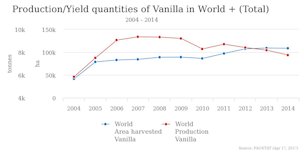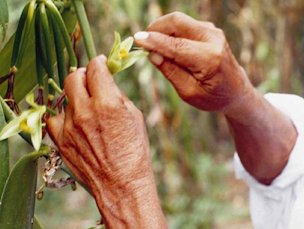Article from
VSCNews, Vegetable and Specialty Crop News
by Alan Chambers
Potential for Commercial Vanilla Production in Southern Florida
Think about your favorite desserts like ice cream, cookies,
cream-filled pastries and chocolate. These indulgences are the perfect
end to an otherwise healthy meal, or a guilty snack when no one’s
looking. Many of our favorite desserts include a common, yet
irresistible, vanillin flavor extract from the “bean” of the vanilla
orchid. Vanillin has enhanced the sensory experience of many foods and
beverages for hundreds of years, and it’s hard to imagine a
contemporary diet without it.
Now imagine your favorite dessert
created with premium, natural vanillin from southern Florida growers
committed to quality, sustainability and the economic viability of
local agriculture. Growing vanilla in southern Florida may be a new
industry for ambitious entrepreneurs, but there are many factors
suggesting that this might be a successful venture.
VANILLA SPECIES
There are approximately 110 species of vanilla orchids, but only a few produce the aroma associated with vanilla extract. Vanilla planifolia
(commercial vanilla) is an emerald green, shade-loving vine native to
the Americas. It was most likely domesticated in southeastern Mexico by
Totonac or Mayan people, and was used by Aztec noble families to flavor
their chocolate drink. V. planifolia
requires warm temperatures, a rainy season and plenty of filtered
sunshine to produce an annual crop of seed pods commonly called “beans.”
Vanilla species other than V. planifolia could also be relevant to an industry in southern Florida. V. x tahitensis is a chance hybrid between V. planifolia and V. odorata,
and is also commercially important on a limited scale. V. pompona is
grown on a very limited scale for pharmaceutical and perfume
applications.

Fig. 1. World production of vanilla, 2004–2014 
There are also four native vanilla species growing in southern Florida’s state parks and nature preserves. These include V. barbellata, V. phaeantha, V. dilloniana and V. mexicana.
These native species are certainly not an immediate solution for
commercial production, but their conservation and characterization
could provide useful genetics for a unique vanilla industry in southern
Florida. Native species can help uncover useful genetic traits
including adaptability to local environmental conditions, disease
resistance, and perhaps unique or enhanced fruit quality.

Fig. 2. Predicttion/yield quantities of Vanilla in World + (Total) 
Unfortunately,
each native Florida orchid is currently endangered and at risk of being
lost before their true value is understood.
VANILLIN
Vanillin
is the world’s most popular spice, and one of the most expensive.
Natural vanillin extract is a premium flavoring and perfuming
ingredient with a presumably insatiable global demand. Approximately 15
million kilograms of vanillin were produced in 2010, worth around
$1,200 to $4,000 per kilogram, with less than 1 percent coming from
vanilla orchids.
A vanilla bean contains about 2 percent
vanillin, though the natural extract contains other components that
also contribute to its quality. Madagascar is regularly the highest
producer of orchid-based vanillin, followed by Indonesia, China and
Mexico. Indonesia, Papau New Guinea, China and Madagascar have the
highest gross production of seed pods (Fig. 1).
The United
States is one of the biggest importers of cured beans and exporters of
the finished product (vanillin extract), worth $26 million in 2004,
according to the Food and Agriculture Organization of the United
Nations. Supply is heavily influenced by environmental and biotic
factors leading to volatility in production and market prices, as shown
for global production from 2004 to 2014 (Fig. 2). Production volume,
quality and price are not equivalent across producing countries.
Demand
for vanillin flavoring from natural sources, including vanilla orchids,
is predicted to increase primarily from 1) growing consumption of
vanillin products including desserts like ice cream and chocolate, and
2) a trending force from major food companies investing in natural
ingredients. This suggests that demand could be increasing specifically
for premium vanillin flavoring from vanilla orchids. Vanilla
cultivation could be suitable for southern Florida based on a favorable
growing environment and high anticipated revenue generation.
CULTIVATION
Vanilla
cultivation requires specific infrastructure. First, vanilla orchids
require shade. Common nursery shade houses would be suitable. Shade has
also been provided by “tutor” trees, including citrus trees in some
countries. In these cases, vanilla cultivation acts as a revenue
generator while new tree plantings are getting established. Otherwise,
the vines require structural support from some other form of
trellising. Vanilla orchids do require an establishment period of a few
years prior to flowering, and research will be needed to optimize this
process for southern Florida.
The pods require thermal
treatments, curing, sweating, drying and extraction to produce the full
flavor of natural vanilla extract. Various postharvest practices are
employed globally and further optimization could increase production
and quality of the finished products. Optimal growth and plant
maintenance methods would therefore need to be established for southern
Florida.

Fig. 3. Manual pollination of Vanilla planifolia.
CURRENT CHALLENGES
V.
planifolia currently requires manual pollination in order to set pods
(Fig. 3). Many homeowners in southern Florida pollinate their own
vanilla orchids. The technique is not complicated, but labor is a major
expense for commercial production. Pollination is achieved using a
small stick to circumvent a physical barrier within the flower (the
rostellum) and introduce pollen onto the stigmatic surface. V. planifolia flowers must be pollinated the morning they open, before the flowers wither and drop off the vine.
The
major pathogens of vanilla are Fusarium oxysporum, Colletotrichum
vanillae and Puccinia sinamononea. Poor cultural practices can increase
disease severity, and cultural practices are therefore often the first
method to reduce disease impacts. Additional control methods might be
necessary for high-density production in southern Florida.
GENETICS AND BREEDING
There are few vanilla cultivars available for commercial production. V. planifolia
is vegetatively propagated and widely distributed, resulting in a lack
of genetic diversity in most commercial systems. This generally
increases the risk of potentially devastating disease epidemics like
growers are currently experiencing in citrus and banana.
Care
must also be taken to obtain virus-free stock material for establishing
a vanillery. These risks could be reduced through a systematic breeding
program focusing on yield, quality and sustainability with regular
improvements to elite cultivars.
Obtaining and increasing stock
material for a vanillery would be relatively straightforward.
Information for establishing and maintaining vanilla plants is also
available from multiple sources. A systematic breeding program could
additionally provide novel and useful cultivars to support a vanilla
industry in southern Florida. The availability of closely related
species could also provide a route to the creation of superior
cultivars, but only sparse information exists for validating this
approach.
V. x tahitensis
is one example of a chance seedling giving rise to a niche industry.
The few native Florida orchids may prove especially interesting,
because they can produce seed pods in their natural environments
without manual pollination. The mechanisms for this specific trait
would be worth study in the future.
CONCLUSION
Vanillin
is a timeless ingredient with increasing demand. Market trends suggest
that demand will especially increase for premium, natural vanillin.
High prices for natural vanillin extract could justify investment for
domestic production. The opportunity for vanilla production in southern
Florida might also justify conservation efforts for our native vanilla
species that could guide future breeding work. In summary, these
challenges and opportunities should resonate with many in our industry,
and are worth further consideration especially when enjoying your next
bowl of ice cream.
Alan Chambers is an assistant
professor at the University of Florida/Institute of Food and
Agricultural Sciences Tropical Research and Education Center in
Homestead
|
|



